At the end of October 2013 I spent a very pleasant and interesting day at S A Brain in Cardiff, helping create my first ever collaboration beer, Brabo, on the Brains Craft Brewery. This piece, published in several parts, documents the experience in detail — you might find it interesting as an insight into the process of brewing, Brains brewery and the craft brewery project, and the origins of the spéciale belge style of Belgian pale ale.
- Spent Grains (introduction)
- The Brains behind the operation (Background to the brewery)
- Very special Belgians (The style and developing the recipe)
- Mashing Brabo
- Boiling Brabo
Hops used for Brains’ regular beers – Challenger, Fuggles, Goldings – are ordered in big pockets but Bill Dobson, Brains head brewer, also keeps a mouthwatering selection of hops for the craft brewery in smaller packs.
The names on the packs and boxes read like an encyclopaedia of international varieties: Amarillo, Bramling Cross, Citra, Cluster, Galaxy, Hallertauer Hersbrucker, Mosaic, Nelson Sauvin, Pacifiica, Styrian Goldings, Summit among other. All are deployed as pellets – hops that have been dried, powdered and compressed.
There’s a school of thought holding that pellets produce generally less interesting and characterful results than the less processed whole leaf hops. Some unquestionably conscientious brewers contend, however, that it makes very little difference, and pellets are more convenient, take up less space and have a longer shelf life. Maintaining quite such a tempting pick ‘n’ mix in whole leaf form would be a lot more expensive and space-hungry.
Brains Craft Brewery is built primarily to handle hop pellets, with the filter in the base of the copper and the whirlpool beneath optimised for this form of hops. At a pinch it can be adapted to handle whole hops and even green hops – two years running, the craft brewery has produced a green hop beer, Green Dragon, including hops grown in the garden of the Tŷ Mawr pub in Lisvane. But Brabo will happily use pellets, which isn’t out of character for the style.
Using an industrial scales, I carefully measure the hops into two buckets: 2kg of East Kent Goldings for the first addition, and a mix of 1kg of Goldings and 1kg of Czech Žatec for the second.
The aromas produced by rubbing the pellets are vivid and almost palpably sensual – light lemon citrus with an undertone of earthiness from the Goldings, and an intensely dreamy waft of new mown hay from the Žatec.
Meanwhile the gravity of the liquid from the mash tun has indeed crept up before winding down. Even after 1,200l of sparge liquor has flowed it’s still 1090, but it drops rapidly to 1060 after 1,700l and a mere 1016 after 2,100l.
Finally, after a good two and a half hours, the last of the wort is pumped into the copper: rather like a giant kettle but with a pump to circulate the contents so the sugars don’t caramelise on the element. At this stage, the best way of telling how much we’ve got is with a wooden dipstick – Bill says no one has ever come up with a better material for the purpose. It turns out we’ve collected 17 barrels (2,780l) at a comfortable original gravity of 1052.
Heating almost 3,000l of liquid to a boil takes time even with an efficient steam element, so there’s plenty of time for the arduous task of cleaning out the mash tun, as detailed in Part 1, and enjoying lunch while discussing the label copy with brand manager Ffion Jones.
She’s delighted with my name. “You’re the first one to come up with a good name straight away,” she says. “With most of them it’s taken forever.” Later that afternoon she’s already looking up the story of Brabo on Wikipedia.
At 1320hrs, our wort finally comes to the boil and, wearing some sturdy gauntlets to protect me from the rising steam, I throw the contents of the first bucket of hops into the copper. The next bucket follows 50 minutes later, for a final 10 minutes on the boil.
Adding hops brings multiple benefits – antibacterial compounds and antioxidants that make beer more resistant to spoilage, as well as the characteristic aromas and bitter flavours that work so miraculously well to bring the grainy, malty character of the base wort into balance.
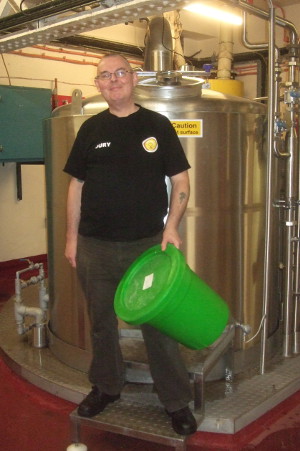
Your author and co-brewer with a bucket recently empty for late hopping in the last 10 minutes of the boil.
But tapping those bitter flavours needs some effort. They originate in components of hop resin known as alpha acids (α-acids) which in their native state won’t dissolve in water. Heating them to high temperatures rearranges their molecular structure, making them soluble, a process known as ‘isomerisation’.
While the wort needs to boil for at least an hour to isomerise sufficient α-acids, this lengthy application of heat has a destructive effect on the essential oils that give hops their distinctive aroma, as these volatile compounds readily evaporate. Thus the late addition of additional hops ensures some of those delightful smells I experienced when crushing the pellets in my hand are captured in the finished product. Not that this is intended to be a hop-forward beer in either aroma or flavour, but subtlety is key.
The boiling stage has several other functions. It sterilises the wort, including neutralising any residual enzymes. In a process known as the ‘hot break’, boiling also precipitates out proteins which otherwise could make the beer hazy and give off flavours. These, and residual hob debris, settle as a powdery residue known as ‘trub’ – I can see it at the bottom of the copper once the liquid has finally drained away. A dose of carrageen (Irish moss) in the hop addition aids this process.
The next stage brings further excitement and exercise as the hopped wort makes its way to the fermentation stage by a rather tortuous route. Now there’s a new set of time critical demands.
The faster the wort is safely sealed in the fermentation vessel (FV) with the right yeast culture, the more likely the fermentation will go to plan, with no wild yeasts or other unwanted infections intruding. But its current temperature would simply kill the yeast, and allowing it to cool naturally would provide more hardy but less benign microorganisms with the opportunity to get in there first.
So the wort will now run through the big brewery’s maze of pipework and an additional set of devices across to the fermentation hall. To reach the hall, we have to go down one set of stairs, across a room and up another set of stairs. This is where the exercise comes in.
First we have to disconnect the pipe that will finally take the wort into the FV, then set everything else up in the fermentation hall, then return to the brewhouse to start pumping. Once the pump is running, we have 38 seconds to get back up to the fermentation hall and reconnect the final pipe. Bill’s mountain biking fitness comes in handy.
As the wort leaves the copper, it first goes through a whirlpool, a sort of spin dryer for wort that uses centrifugal force to extract the last of the trub. Then, up in the fermentation hall, it runs through a heat exchanger. This is essentially a development of the system we used earlier to cool a sample for the saccharometer test, the flask with the double wall.
In the exchanger, watertight plates create narrow rectangular chambers, with hot wort and cold water flowing through alternate chambers. Thanks to the laws of thermodynamics, the energy in the wort is transferred to the water, which is returned to the brewery’s hot liquor supply.
The craft brewery has its own heat exchanger and it’s remarkably compact and efficient, cooling the wort from near-boiling to 16-17°C in next to no time. Opposite is the main brewery’s equivalent kit, a massive thing the size of two grand pianos on their sides – the differential is less to do with the volumes, more to do with the fact that the senior heat exchanger is now several decades old.
And then there’s another surprise: in the line between the heat exchanger and the FV is a compressed oxygen supply, which hisses deafeningly as Bill switches it in. Oxygen, brewers will tell you, is the sworn enemy of good beer, as oxidation causes stale off flavours and encourages infections, unless we’re dealing with a long ageing strong beer where a bit of oxidation can make things interesting.
But yeast is an aerobic microorganism that needs oxygen to function. The wort will pick up some oxygen from the air as it splashes into the tank, but adding an extra dose of pure oxygen helps get fermentation off to a vigorous start.
Much less surprising is the fact that most of Brains’ output now ferments in contemporary cylindroconical vessels, though there are some traditional squares still in use. These are vast things topped by heavy lids with glass viewing ports: when empty, they look like steel lined cells in which some science fiction villain might imprison opponents.
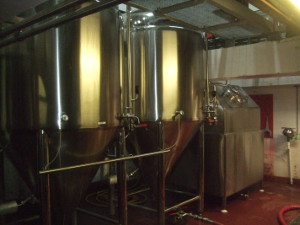
Brains Craft Brewery’s own fermentation vessels, two cylindroconicals and a square. Brabo is destined for the middle vessel.
Eerier still is a whole unlit hall full of disused squares inherited from Bass but now surplus to capacity, a sudden zone of abandonment in such an obviously busy and well maintained place. Thinking back to the story of the ancient mash tun, I wonder if these, too, have been checked for skeletons recently.
The craft brewery has its own pair of cylindroconicals, and my cooled and oxygenated wort is now rapidly filling the second one, FV2. There’s a small square fermenter for the craft brewery too, but the cylindroconicals are more appropriate for my beer. Another dipstick reveals we’ve ended up with 2,613l, or 16 barrels – about what we were aiming for.
In the next door vessel, my competitor Glenn Payne’s Rye PA is fermenting merrily away with a healthy barm of yeast. Setting aside any fleeting thoughts of industrial sabotage, I turn my attention to the three flasks Bill has just brought through from the lab – all tall, narrow 11.4l Cornelius soft drinks kegs of the sort now popular with home brewers.
One of Bill’s colleagues has been nurturing our Ardennes yeast in these since it arrived a week or so before from the USA, as liquid yeast in a sealed pack with an internal nutrient system.
Bill attaches a length of rubber tubing to the first keg and I hold the other end, pointing it over the hatch at the top of the FV. The little tube is tiny in comparison to the tall vessel with its thousands of litres of wort, but it will shortly convey the microscopic organisms that will bring my Brabo to life. Over the next few days they’ll multiply by the billions, in the process breaking down all those sugars we’ve so painstakingly created into alcohol and carbon dioxide, hopefully resulting in a tasty and drinkable as well as mildly intoxicating beverage.
The energy liberated won’t quite power a small town, but it will raise the temperature of the liquid to a balmy 21°C for days on end. I’m trying to avoid thinking of insemination metaphors, but I can understand why our brewing forbears got all mystical about fermentation.
The pressure as Bill turns the valve catches me by surprise and some of the yeasty liquid splashes where it shouldn’t, but the rest cascades into the waiting wort. The next two kegs aren’t quite so lively and one has to be upended by hand. And so we close the lid of the FV and our task is done.
Now the real waiting begins. Although he’s never worked with this particular yeast strain before, Bill’s brewer’s sense is telling him not to expect any signs of life for a day or so. He turns out to be right again, but a few days later the yeasts will be working at vigorous pace. After that, Brabo will be racked into a conditioning tank to settle for a few days. And then…?
Well, those quaint flow diagrams in old editions of the Good Beer Guide from which I gleaned my first knowledge of brewing always used to end with a moral parting of the ways. The way of goodliness led, of course, towards cask conditioning and the trusty pub handpump. But Brabo, I’m afraid, is largely heading the way of the devil.
Most will be cold filtered, but not pasteurised, and bottled or kegged – in line with many of the beers that inspired it, which are usually filtered but unpasteurised in the keg, and none the worse for it. But Bill will also fill and condition a few firkins, some of which are headed for a pub near me.
I’m intrigued to find out how the beer does in cask. A few years back, J D Wetherspoon occasionally tanked unfiltered De Koninck to Britain for casking so they could serve a ‘real ale’ version in their pubs. I never did get to try it, and reports were not wholly positive, but it was an interesting idea.
Before I leave, Bill shows me round the bits of the brewery I haven’t seen, including the craft brewery’s own small scale bottling and kegging plant with its hand operated machine for the smallest runs. This is actually the only regularly used packaging equipment in the brewery as Brains has outsourced all its packaging and logistics, most of it to Marston’s.
I wonder if the patriotic rugby fan cracking open a bottle of SA Gold in anticipation of settling down to watch Wales thrash England realises the beer he’s drinking has crossed the border twice.
I’m not expecting Brabo to be a world beating brew. There are far too many of those already, and I’d settle for something pleasantly drinkable, knowing I had an input into creating it. But no matter what the result, this whole day has been an education, and reinforced my already extensive admiration for brewers and their work.
But I forget. Now I’m a brewer too. At least just a little bit.
POSTCRIPT. Brabo was judged by an invited panel alongside six other beers made at Brains Craft Brewery in London on 5 December 2013. All the beers were then served at the British Guild of Beer Writers’ annual dinner later in the day.
Brabo didn’t win – that honour went to Glenn Payne’s excellent Rye IPA, Rye Catcher. No rankings or runners-up were officially announced but I was told informally that I had nothing to be ashamed of. Many of the guests at the Beer Writers’ dinner commented favourably on the beer.
If you’d like to try Brabo on cask, visit the Dog and Bell, 118 Prince Street, London SE8 3JD on Friday 13 December when we’ll be opening one of the few casks. I’ll be there from 1900hrs to answer questions about the beer.





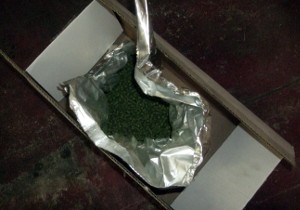

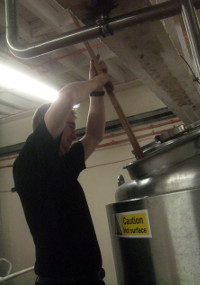

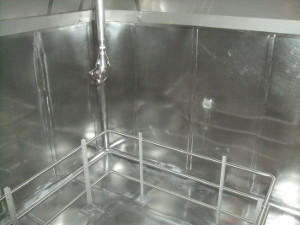
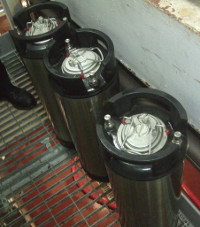
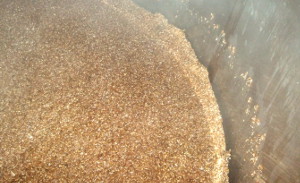


Leave a Reply